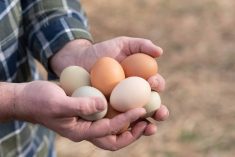By the time the paper version of this issue reaches you (around May 28), we’ll probably know whether Canada’s rail engineers, conductors and yard workers have reached a new collective bargaining agreement, or hit the picket line for yet another strike, or been legislated back to work. Prairie grain farmers have already seen this movie too many times, and the new plot twist — that both major railways could halt service at the same time — may not even matter to many growers, who are often described as “captive shippers” to one line or the other.
The contracts for Teamster-affiliated workers at both CN and CPKC expired at the end of December. The earliest possible date for a strike is now May 22, although at time of writing, the feds were seeking an opinion from the Canada Industrial Relations Board on possible safety implications — say, if rural hospitals were to run out of propane for backup generators. The board’s ruling could possibly put a strike date further out.
UPDATES SINCE PRESS TIME:
Rail strike won’t happen this month, CPKC says (May 16)
No progress on rail strike negotiations, say union, companies (May 23)
Read Also

Gentle treatments for pain in the neck
Heading toward year-end, people unknowingly tense up against the cold and busyness, causing neck pain that can often be treated with appropriate support and gentle mobility, athletic therapist Kathlyn Hossack says.
This time it’s too early for farmers down east to be concerned about availability of propane to dry grain, leaving Prairie farm groups to air the usual concerns: the risks of plugged grain elevators, delayed deliveries and payments, demurrage costs and another deep scuff on Canada’s reputation as a reliable grain exporter. The organizations and politicians who usually call on the railways and unions to resolve their issues peacefully, while also calling on Ottawa to make very sure they do — through back-to-work legislation, if need be — have long since made those calls. The repetitiveness of it all doesn’t make it any less frustrating for farmers, and rightly so.
Now, from where I sit, it’s been informative to watch the current federal government’s approach to rail strikes, compared to its Conservative predecessor — and how the railways and unions have reacted as the Liberals have hesitated even to mention back-to-work legislation as an option.
For example, CP conductors and engineers were legislated back to work in 2012; then they agreed to binding arbitration in 2015 after a one-day strike with a back-to-work law again ready to roll in the Commons. After the 2015 election, I was waiting to see whether maybe avoiding such legislation would set up conditions for more durable labour peace.
Not so much. After the election, that same bargaining unit wound up in another one-day strike in 2018 before reaching a four-year deal. And when that expired, in 2022, we saw a three-day work stoppage followed by binding arbitration.
Over at CN, the conductors and company were in lockout/strike position in 2010 and only reached a deal with a federal mediator in “last-chance” meetings. Then in 2013, mediation broke down and two tentative agreements — the second of which was reached under threat of back-to-work legislation — were rejected by employees before the two sides agreed to binding arbitration in 2014. After the election, the conductors and yard workers in 2019 reached a deal with CN only after an eight-day strike.
“Previous governments routinely violated workers’ right to strike when it came to the rail industry,” Teamsters president Francois Laporte said at the time. “This government remained calm and focused on helping parties reach an agreement, and it worked.”
Did it, though? I’d wondered if taking ad hoc back-to-work laws off the table would maybe motivate the railways and unions to take good-faith bargaining more seriously, and reach workable deals without threatening strikes or lockouts — and as this month’s events show, that hasn’t happened.
It’s been suggested by third parties that some federal form of “essential service” designation be imposed on railways, forcing all rail labour disputes into arbitration, where so many end up anyway. Attractive as that sounds, it might just further codify what some experts call “permanent exceptionalism.” In other words, industries and lawmakers of all parties could keep talking about how they support workers’ rights to collective bargaining, but, you know, not in this sector. Or this one. Or that one.
And then where do you stop? How low would the stakes have to be? Well, you may recall when CN’s IBEW-led signal workers in 2022 lingered on strike for 17 days before going to arbitration — in part, I assume, because their strike never stopped rail traffic in any way you or I would have noticed.
As infuriating as strikes may be, the alternative could well put us all on a slippery slope to a Canada where collective action is our inalienable right — but only as long as it never inconveniences anyone at all.
Flared out
My family and I took a quick road trip out of town on the Mother’s Day weekend to get a better look at that latest splash of northern lights, which could be seen well into some parts of the U.S. But if you’ve been using real-time kinematic (RTK) positioning or other such GPS systems for navigation during seeding, you may have been less than impressed.
On top of a planned outage in the second half of May for one of the satellites in the WAAS constellation, it’s believed that the run of solar flares and “coronal mass ejections” that created those great auroras caused geomagnetic storms that have further disrupted satellite signals. One Manitoba farmer told a reporter from our shop he was suddenly seeing large skips and overlaps of up to half his seeder width while he had auto steer engaged. Further south, other farmers were reporting distorted corrections and “drastic” heading changes.
Did this affect your seeding work in mid-May? And what did you do to deal with it? We’d also be interested to hear if that run of reduced accuracy causes any problems when you go back into the same fields to spray or harvest — for example, if you use a system such as Deere’s AutoPath that creates guidance lines off a first pass for use in future passes through a crop. Drop us a line and let us know.
















